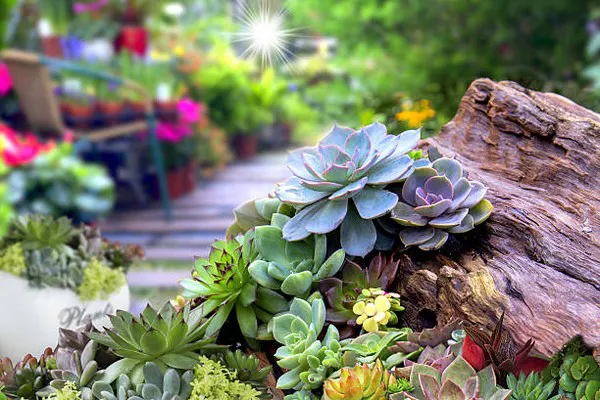Succulent plants have gained immense popularity in recent years due to their unique beauty, low maintenance requirements, and adaptability to various environments. While succulents are primarily known for their fleshy leaves and striking forms, many species also produce stunning flowers. In this article, we delve into the diverse world of succulent flowers, exploring their uses, care tips, and the creative possibilities they offer.
Unveiling the Beauty of Succulent Flowers
1. A Delightful Surprise: Succulent enthusiasts are often captivated by the unexpected beauty of these plants’ blooms. While the focus is typically on their distinctive foliage, the emergence of colorful and intricate flowers adds an extra layer of intrigue to these plants. From the delicate petals of Echeveria flowers to the vibrant clusters of Kalanchoe blossoms, succulent flowers come in a remarkable array of shapes and colors.
2. Blossoming Patterns: Succulent flowers showcase various growth patterns, depending on the species. Some succulents produce tall and elegant flower stalks that rise above the rosette of leaves, while others form compact clusters of blooms nestled among the foliage. This diversity in flowering habits contributes to the charm and uniqueness of each succulent variety.
Enhancing Indoor and Outdoor Spaces
1. Container Gardening
Succulent flowers are excellent candidates for container gardening. Their compact size and fascinating blooms make them ideal for adorning windowsills, balconies, and small outdoor spaces. A carefully curated collection of succulents with different flowering times can provide a continuous display of color throughout the year.
2. Living Arrangements
Succulent flowers can be integrated into living arrangements, adding a touch of nature’s elegance to indoor decor. Incorporating succulent blooms into floral centerpieces or wreaths can infuse a sense of freshness and uniqueness into any space.
3. Vertical Gardens
Vertical gardening has gained popularity as a space-saving solution for both indoor and outdoor environments. Succulent flowers can be integrated into vertical garden designs, creating living artworks that showcase the beauty of both the plants and their blossoms.
Celebratory Occasions and Gifts
1. Weddings and Events
Succulent flowers have become a trendy choice for weddings and events. Their distinctive appearance and ability to retain their freshness for extended periods make them suitable for bridal bouquets, boutonnieres, and table centerpieces. The symbolism of resilience and endurance often associated with succulents also adds a meaningful layer to such occasions.
2. Thoughtful Gifts
A potted succulent adorned with blossoms can make for a unique and lasting gift. Whether it’s a birthday, anniversary, or a gesture of appreciation, succulent flowers serve as a reminder of nature’s beauty and the lasting bond between the giver and receiver.
Caring for Succulent Flowers
1. Light and Sun Exposure
Adequate light is crucial for the health and blooming of succulent flowers. Most succulents thrive in bright, indirect sunlight. Placing them near windows with filtered light or outdoors in areas with partial sun exposure is ideal. However, it’s important to avoid exposing succulents to intense, direct sunlight for extended periods, as it can lead to sunburn.
2. Watering Wisely
Succulents are known for their water-storing abilities, but their watering needs can vary. While they don’t require frequent watering, it’s important to water them thoroughly when the top inch of soil feels dry. Overwatering can lead to root rot, so it’s advisable to allow the soil to dry out between waterings.
3. Temperature and Humidity
Succulents generally prefer warmer temperatures and low humidity. They thrive in environments where the temperature range is between 60 to 80 degrees Fahrenheit (15 to 27 degrees Celsius). Avoid placing succulents in areas with high humidity, as it can increase the risk of fungal diseases.
4. Soil and Fertilization
Well-draining soil is essential for succulents to prevent waterlogging. Using a specialized succulent or cactus mix that promotes drainage is recommended. Fertilize sparingly, usually during the active growing season (spring and summer), with a diluted, balanced fertilizer.
5. Pruning and Deadheading
Regular maintenance can encourage healthy growth and prolonged blooming. Removing spent flower heads, a process known as deadheading, directs the plant’s energy towards producing new blooms. Additionally, pruning leggy growth and offsets (baby plants that emerge from the main plant) can help maintain a compact and vibrant appearance.
Preserving Succulent Flowers
1. Drying Techniques: Preserving succulent flowers allows you to enjoy their beauty long after they’ve bloomed. Air drying is a popular method that involves hanging the flowers upside down in a cool, dry place. Pressing the flowers between heavy books or using silica gel can also yield impressive results.
2. Crafting and Art: Dried succulent flowers can be used in various craft projects, such as creating decorative frames, greeting cards, or even jewelry. Their unique textures and colors add a touch of nature-inspired artistry to these creations.
Conclusion
Succulent flowers offer a world of possibilities, from enhancing indoor and outdoor spaces to becoming the stars of special occasions. Their diverse forms and colors, coupled with their low maintenance requirements, make them a favorite among both seasoned gardeners and novices. By understanding the unique needs of succulent flowers and exploring their creative potential, enthusiasts can cultivate not only stunning displays but also a deeper appreciation for the beauty and resilience of these remarkable plants.


